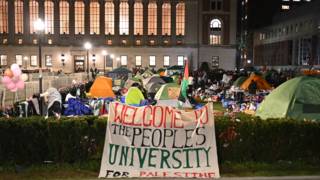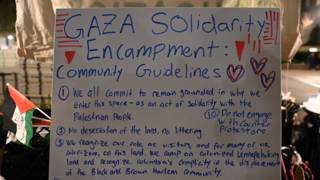
Related
Guests
- Nikole Hannah-Jonesaward-winning reporter at The New York Times Magazine covering racial injustice. Her most recent piece is headlined “The Resegregation of Jefferson County.” Her article about choosing a school for her daughter in a segregated school system won a National Magazine Award this year.
As students return to school across the country, we continue our look at the resegregation of schools—particularly in Alabama. A new article in this week’s New York Times Magazine titled “The Resegregation of Jefferson County” by Nikole Hannah-Jones looks at how predominantly white towns in Alabama are increasingly pulling out of regional school districts and creating new schools that are overwhelmingly white. Critics say this is a new form of segregation. For more, we speak with Nikole Hannah-Jones. Her article about choosing a school for her daughter in a segregated school system won a National Magazine Award this year.
Transcript
AMY GOODMAN: As students return to school across the country, we turn now to look at the resegregation of schools. Today, we look at Alabama. A new article in this week’s New York Times Magazine headlined “The Resegregation of Jefferson County,” by Nikole Hannah-Jones, looks at how predominantly white towns in Alabama are increasingly pulling out of regional school districts and creating new schools that are overwhelmingly white. Critics say this is a new form of segregation.
Well, we’re joined by Nikole Hannah-Jones in our studio. Her article about choosing a school for her daughter in a segregated school system won a National Magazine Award this year.
Welcome back to Democracy Now!, Nikole. So, talk about what you’re finding and why you chose to look at Jefferson County.
NIKOLE HANNAH-JONES: So, one of the reasons that integration was so successful by court order in the South was the South tends to operate countywide school systems. And that meant that white parents wanting to flee desegregation couldn’t just simply move into a white town to get away from these orders. But what we’re finding in Alabama, and really across the country, are white communities, wealthier white communities, wanting to pull away from these regional or countywide school districts and form their own racially isolated, much more wealthy school districts. And that’s happened in Jefferson County, Alabama.
The reason I looked at that case, in particular, is, most of the time when white communities want to—they’re called school district secessions. When they want to secede from a larger school district, there’s very little scrutiny, and we don’t actually get to see their motivations. But the school system that this town, this suburban community called Gardendale, wanted to split off from was under a desegregation order, so they actually had to go to trial, and there was discovery. And in that discovery, the racial motivations of the white people in that community became very clear. So it provided an unusual opportunity to actually explore why communities who say they want to break off from local control are often motivated by race.
AMY GOODMAN: That trial is fascinating, that you write about. And in it, the judge actually reads from Brown v. Board of Education. Especially for young people who don’t even know what that is, more than half a century ago, explain what happened then and why it applies now, and why this judge found it important to recite it in court.
NIKOLE HANNAH-JONES: So, Brown v. Board of Education, of course, is the landmark Supreme Court ruling that found legally mandated school segregation unconstitutional.
AMY GOODMAN: Back in 1954.
NIKOLE HANNAH-JONES: Back in 1954. Prior to that, we operated under the Plessy v. Ferguson doctrine, which said segregation of black citizens was legal and constitutional as long as it was equal. Of course, it was never equal. But Brown doesn’t actually deal with that. It deals with citizenship. And it’s basically saying that the separation of black students from white denies them their full citizenship.
The way that we kind of commonly learn this history, though, is the Supreme Court makes this ruling, and then we all agree segregation was bad, and we integrate our schools, or we tried really hard. But actually what happened was there was massive resistance, both in the North and the South. And it takes a very long time for school desegregation to occur, where it occurred at all, largely because of these court orders.
What was so fascinating about this trial, though, is many federal judges have basically taken the position that these court orders, some of them 50 years old, have gone on too long and that there’s no more segregation for them to deal with. But Judge Madeline Haikala, who was appointed by President Obama, has been one of the rare federal judges who is taking these rulings very seriously. And I was reading through the court transcripts. There was just this amazing moment where she’s interviewing the superintendent that the all-white school board of Gardendale appointed, and found out that he—on cross-examination, it came out that he had never hired or worked with a black teacher in his career, even though he was coming down to, basically, Birmingham, Alabama. And so, I think—she declined to be interviewed for the story, but it’s clear that she calls a recess, she goes and gets copies of the Brown ruling and begins to question him about had he ever read the ruling, and then reads parts of it, particularly the parts about how segregation demeans black students, aloud. And it was amazing moment. I’ve written about school segregation for more than a decade. I’ve sat in on these trials. I’ve read transcripts. I’ve never seen a judge do that before.
AMY GOODMAN: And so, explain what happened in Gardendale.
NIKOLE HANNAH-JONES: What’s the status of the case right now? So, she does this really interesting ruling. She finds that Gardendale was in fact motivated by racism, which is a very rare thing for a judge to find these days. But she kind of splits the baby. So, Gardendale wanted to break off. She, in the ruling—
AMY GOODMAN: To secede, the school system—
NIKOLE HANNAH-JONES: To secede, yes.
AMY GOODMAN: —which is quite amazing, even to be called that.
NIKOLE HANNAH-JONES: Yeah, exactly. It’s evocative of kind of all the right things, I think. She allows them, in her ruling, to take over two of the elementary schools in the town, and says she’s going to watch over the case and see, you know, how do they act, basically, with the black students that they have to bus in because of this court order. And if all goes well, then she would allow them to form their own district. So, the NAACP Legal Defense Fund, which was fighting the secession, clearly didn’t agree with that ruling. But when you read it, you see she was very conflicted about what to do with this case, understanding that if she didn’t allow them to break off, it could be very soon that Jefferson County would be released from this court order, and Gardendale could do whatever it wanted. And by allowing them to break off, she could put them under their own desegregation order and watch them longer. I think it really gets to the challenge of undoing racial caste in this country. It is not easily done.
AMY GOODMAN: I want to ask you to stay after the show so we can continue to talk about this and some of the players, and also your own pursuit of a school for your daughter, not in Alabama, but here in New York. Nikole Hannah-Jones is the award-winning reporter for The New York Times Magazine. We’ll link to her piece, “The Resegregation of Jefferson County.”
That does it for our show. Democracy Now!’s Juan González is in California, Los Angeles. Check our website for his book tour.











Media Options